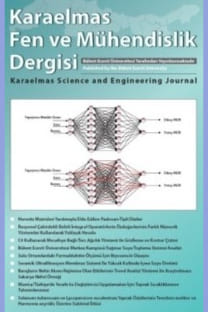Sol-jel Kaplama Çözeltisi Bileşiminin Hidrojen Peroksit Yanıtlarına Etkisi
Sol-jel, Elektrot modifikasyonu, Seçimli geçirgen membran, Hidrojen peroksit
Effect of the Composition of Sol-gel Coating Solution on Responses of Hydrogen Peroxide
___
- Bard, AJ., Faulkner, LR. 2001. Electrochemical methods, fun- damentals and applications, Wiley, New York.
- Brinker, CJ., Scherer, GW. 1989. Sol-gel science, Academic Press, New York.
- Chou, TP., Chandrasekaren, C., Cao, GZ. 2003. Sol-gel-derived hybrid coatings for corrosion protection. J. Sol-Gel Sci. Tech- nol., 26:321-327.
- Collinson, MM. 2002. Recent trends in analytical application of organically modified silicate materials. Trends Anal. Chem., 21:30-38.
- Dash, S., Mishra, S., Patel, S., Mishra, BK. 2008. Organically modified silica: Synthesis and applications due to its sur- face interaction with organic molecules. Adv. Colloid Inter- face Sci., 140:77-94.
- Diamond, D. 1998. Principles of chemical and biological sen- sors, Wiley, New York.
- Guglielmi, M. 1997. Sol-gel coatings on metals. J. Sol-Gel Sci. Technol., 8:443-449.
- Gupta, R., Mozumdar, S., Chaudhury, NK. 2005. Effect of eth- anol variation on the internal environment of sol-gel bulk and thin films with aging. Biosens. Bioelectron., 21:549-556.
- Haryadi, H. 2005. Porous hybrid organic-inorganic silica materials: preparation, structural and transport properties. PhD Thesis, The University of New South Wales Australia.
- Li, J., Chia, LS., Goh, NK., Tan SN., Ge, H. 1997. Mediated amperometric glucose sensor modified by the sol-gel method. Sens. Actuators B, 40:135-141.
- Lyons, MEG. 1996. Electroactive polymer electrochemistry. Part 2: Methods and applications, Plenum Press, New York. Macan, J., Ivankovic, H., Ivankovic, M., Mencer, HJ. 2004.
- Synthesis and characterization of organic-inorganic hybrids based on epoxy resin and 3- glycidyloxypropyltrimethoxsysilane. J. Appl. Poly. Sci., 92:498-505.
- Mackenzie, JD., Bescher, EP. 2000. Physical properties of solgel coatings. J. Sol-Gel Sci. Technol., 19:23-29.
- Matejka, L., Dukh, O., Brus, J., Simonssick Jr., WJ., Meissner, B. 2000. Cage-like structure formation during sol-gel polymerization of glycidyloxypropyltrimethoxy silane. J. Non-Cryst. Solids, 270:34-47.
- Pauliukaite, R., Paquim, AMC., Brett, AMO., Brett, CMA. 2006. Electrochemical, EIS and AFM characterization of biosensors: Trioxysilane sol-gel encapsulated glucose oxidase with two different redox mediators. Electrochim. Acta, 52:1-8.
- Sayılkan, H., Şener, Ş., Şener, E., Sülü, M. 2003. The sol-gel synthesis and application of some anticorrosive coating materials. Mater. Sci., 39:733-739.
- Tatar, P., Kiraz, N., Asiltürk, M., Sayılkan, F., Sayılkan, H., Arpaç, E. 2007. Antibacterial thin films on glass substrate by sol-gel process. J. Inorg. Organomet. Poly. Met., 17:525-533.
- Tripathi, VS., Kandimalla, VB., Ju, H. 2006. Preparation of ormosil and its application in the immobilizing biomolecules. Sens. Actuators B, 114:1071-1082.
- Uyanık, M., Arpaç, E., Schmidt, H., Akarsu, M., Sayılkan, F., Sayılkan, H. 2006. Heat-resistant hydrophobic-oleophobic coating. J. Appl. Poly. Sci., 100:2386-2392.
- Walcarius, A. 2001. Electroanalysis with pure, chemically modified and sol-gel derived silica-based materials. Electroanalysis, 13:701-718.
- Walcarius, A., Mandler, D., Cox, JA., Collinson, M., Lev, O. 2005. Exciting new directions in the intersection of functionalized sol-gel materials with electrochemistry. J. Mater. Chem., 15:3663-3689.
- Wang, J. 1991. Modified electrodes for electrochemical sensors. Electroanalysis, 3:255-259.
- Wang, J. 2000. Analytical electrochemistry, Wiley, New York. Wen, J., Wilkes, GL. 1996. Organic/inorganic hybrid network materials by the sol-gel approach. Chem. Mater., 8:1667-1681.
- Wu, J., Suls, J., Sansen, W. 1999. Amperometric glucose with enzyme covalently immobilized by sol-gel technology. Anal. Sci., 15:1029-1032.
- ISSN: 2146-4987
- Yayın Aralığı: 3
- Başlangıç: 2011
- Yayıncı: ZONGULDAK BÜLENT ECEVİT ÜNİVERSİTESİ
Sol-jel Kaplama Çözeltisi Bileşiminin Hidrojen Peroksit Yanıtlarına Etkisi
Nizamettin DEMİRKIRAN, Ergun EKİNCİ
Düşük Plastisiteli Bir Kilde Katkı Olarak Çelikhane Curufunun Kullanılması ve Kireç ile Etkileşimi
Gamze BİLGEN, Aydın KAVAK, Ömer Faruk ÇAPAR
Genelleştirilmiş Lineer Karma Modellerde Tahmin Yöntemlerinin Uygulamalı Karşılaştırılması
